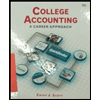
ACC 201/202 MYACCLAB E-TEXT ONLY >I<
16th Edition
ISBN: 9781323118047
Author: Pearson
Publisher: PEARSON C
expand_more
expand_more
format_list_bulleted
Concept explainers
Question
Chapter 5, Problem 5.39BP
To determine
Purchases is an activity of acquiring the merchandise inventory of a business.
Sales is an activity of selling the merchandise inventory of a business.
To Record: The purchase and sales transactions of Company T during January 2016.
Expert Solution & Answer
Want to see the full answer?
Check out a sample textbook solution
Students have asked these similar questions
Can you solve this financial accounting question with the appropriate financial analysis techniques?
Not use ai solution please and accounting question
subject = general accounting
Chapter 5 Solutions
ACC 201/202 MYACCLAB E-TEXT ONLY >I<
Ch. 5 - Which account does a merchandiser use that a...Ch. 5 - The two main inventory accounting systems are the...Ch. 5 - The journal entry for the purchase of inventory on...Ch. 5 - JC Manufacturing purchase d inventory for 5,300...Ch. 5 - Prob. 5QCCh. 5 - Suppose Daves Discounts Merchandise Inventory...Ch. 5 - Which of the following accounts would be closed at...Ch. 5 - What is the order of the subtotals that appear on...Ch. 5 - Prob. 9QCCh. 5 - The journal entry for the purchase of inventory on...
Ch. 5 - What is a merchandiser, and what is the name of...Ch. 5 - Prob. 2RQCh. 5 - Describe the operating cycle of a merchandiser.Ch. 5 - What is Cost of Goods Sold (COGS), and where is it...Ch. 5 - How is gross profit calculated, and what does it...Ch. 5 - What are the two types of inventory accounting...Ch. 5 - What is an invoice?Ch. 5 - What account is debited when recording a purchase...Ch. 5 - Prob. 9RQCh. 5 - What is a purchase return? How does a purchase...Ch. 5 - Prob. 11RQCh. 5 - How is the net cost of inventory calculated?Ch. 5 - What are the two journal entries involved when...Ch. 5 - When granting a sales allowance, is there a return...Ch. 5 - Prob. 15RQCh. 5 - Prob. 16RQCh. 5 - Prob. 17RQCh. 5 - What are the four steps involved in the closing...Ch. 5 - Prob. 19RQCh. 5 - Prob. 20RQCh. 5 - Prob. 21RQCh. 5 - Prob. 22RQCh. 5 - Prob. 23ARQCh. 5 - When recording purchase returns and purchase...Ch. 5 - What account is debited when recording the payment...Ch. 5 - Prob. 26ARQCh. 5 - Is an adjusting entry needed for inventory...Ch. 5 - Highlight the differences in the closing process...Ch. 5 - Describe the calculation of cost of goods sold...Ch. 5 - Comparing periodic and perpetual inventory systems...Ch. 5 - Journalizing purchase transactions Consider the...Ch. 5 - Journalizing purchase transactions Consider the...Ch. 5 - Journalizing sales transactions Journalize the...Ch. 5 - Journalizing purchase and sales transactions...Ch. 5 - Adjusting for inventory shrinkage Carlas...Ch. 5 - Journalizing closing entries Rockwall RV Centers...Ch. 5 - Use the following information to answer Short...Ch. 5 - Use the following information to answer Short...Ch. 5 - Computing the gross profit percentage Morris...Ch. 5 - Journalizing purchase transactions-periodic...Ch. 5 - Prob. 5.12SECh. 5 - Journalizing closing entries-periodic inventory...Ch. 5 - Computing cost of goods sold in a periodic...Ch. 5 - For all exercises, assume the perpetual inventory...Ch. 5 - Journalizing purchase transactions from an invoice...Ch. 5 - Journalizing purchase transactions Hartford...Ch. 5 - Computing missing amounts Consider the following...Ch. 5 - Journalizing sales transactions Journalize the...Ch. 5 - Journalizing purchase and sales transactions...Ch. 5 - Journalizing adjusting entries and computing gross...Ch. 5 - Use the following information to answer Exercises...Ch. 5 - Prob. 5.23ECh. 5 - Use the following information to answer Exercises...Ch. 5 - Computing the gross profit percentage Cupcake...Ch. 5 - Journalizing purchase transactionsperiodic...Ch. 5 - Journalizing sales transactions-periodic inventory...Ch. 5 - Journalizing purchase and sales...Ch. 5 - Journalizing dosing entries-periodic inventory...Ch. 5 - Computing cost of goods sold in a periodic...Ch. 5 - Journalizing purchase and sale transactions...Ch. 5 - Journalizing purchase and sale transactions...Ch. 5 - Preparing a multi-step income statement,...Ch. 5 - Journalizing adjusting entries, preparing adjusted...Ch. 5 - Preparing a single-step income statement,...Ch. 5 - Journalizing purchase and sale...Ch. 5 - A Preparing a multi-step income statement and...Ch. 5 - Journalizing purchase and sale transactions...Ch. 5 - Prob. 5.39BPCh. 5 - Prob. 5.40BPCh. 5 - Journalizing adjusting entries, preparing adjusted...Ch. 5 - Prob. 5.42BPCh. 5 - Prob. 5.43BPCh. 5 - Preparing a multi-step income statement and...Ch. 5 - Journalizing purchase and sale transactions,...Ch. 5 - Journalizing purchase and sale transactions,...Ch. 5 - Comprehensive Problem for Chapters 1-5 Completing...Ch. 5 - Prob. 5.1CTDCCh. 5 - Dobbs Wholesale Antiques makes all sales under...Ch. 5 - Rae Philippe was a warehouse manager for Atkins...Ch. 5 - Prob. 5.1CTFSC
Knowledge Booster
Learn more about
Need a deep-dive on the concept behind this application? Look no further. Learn more about this topic, accounting and related others by exploring similar questions and additional content below.Similar questions
- Please explain the solution to this general accounting problem with accurate explanations.arrow_forwardCan you explain the correct methodology to solve this financial accounting problem?arrow_forwardI am looking for the correct answer to this general accounting question with appropriate explanations.arrow_forward
- Quick answer of this accounting questionarrow_forwardI am searching for the accurate solution to this financial accounting problem with the right approach.arrow_forwardQ1. S-Sports Ltd specialises in selling premium sports equipment. Over the month, it recorded the following transactions. - Incurred $10,000 on credit for a one-time promotional event organised for its customers and local sports team. This amount will be paid in the coming month. - Made sales of $50,000 to customers, of which $5,000 is credit sales and will be collected in the following month. The goods sold were purchased from a local supplier at $20,000. -Purchased $15,000 of goods from a supplier on credit, with payment due in 30 days. - Paid rents of $12,000 for three months, with this month being the first month. -Repaired a window broken by a typhoon in summer. The repair cost is $3,000 in cash. -Paid supplier $25,000 for goods purchased last month. -Collected $8,000 in advance and promised to deliver goods the following month. -Incurred $1,800 depreciation expense and $9,000 other operating expenses. The operating expenses will be paid early next month. Q. For each item…arrow_forward
arrow_back_ios
SEE MORE QUESTIONS
arrow_forward_ios
Recommended textbooks for you
 Cornerstones of Financial AccountingAccountingISBN:9781337690881Author:Jay Rich, Jeff JonesPublisher:Cengage Learning
Cornerstones of Financial AccountingAccountingISBN:9781337690881Author:Jay Rich, Jeff JonesPublisher:Cengage Learning College Accounting (Book Only): A Career ApproachAccountingISBN:9781305084087Author:Cathy J. ScottPublisher:Cengage Learning
College Accounting (Book Only): A Career ApproachAccountingISBN:9781305084087Author:Cathy J. ScottPublisher:Cengage Learning College Accounting, Chapters 1-27AccountingISBN:9781337794756Author:HEINTZ, James A.Publisher:Cengage Learning,
College Accounting, Chapters 1-27AccountingISBN:9781337794756Author:HEINTZ, James A.Publisher:Cengage Learning, College Accounting (Book Only): A Career ApproachAccountingISBN:9781337280570Author:Scott, Cathy J.Publisher:South-Western College Pub
College Accounting (Book Only): A Career ApproachAccountingISBN:9781337280570Author:Scott, Cathy J.Publisher:South-Western College Pub College Accounting, Chapters 1-27 (New in Account...AccountingISBN:9781305666160Author:James A. Heintz, Robert W. ParryPublisher:Cengage Learning
College Accounting, Chapters 1-27 (New in Account...AccountingISBN:9781305666160Author:James A. Heintz, Robert W. ParryPublisher:Cengage Learning Accounting (Text Only)AccountingISBN:9781285743615Author:Carl Warren, James M. Reeve, Jonathan DuchacPublisher:Cengage Learning
Accounting (Text Only)AccountingISBN:9781285743615Author:Carl Warren, James M. Reeve, Jonathan DuchacPublisher:Cengage Learning

Cornerstones of Financial Accounting
Accounting
ISBN:9781337690881
Author:Jay Rich, Jeff Jones
Publisher:Cengage Learning

College Accounting (Book Only): A Career Approach
Accounting
ISBN:9781305084087
Author:Cathy J. Scott
Publisher:Cengage Learning

College Accounting, Chapters 1-27
Accounting
ISBN:9781337794756
Author:HEINTZ, James A.
Publisher:Cengage Learning,

College Accounting (Book Only): A Career Approach
Accounting
ISBN:9781337280570
Author:Scott, Cathy J.
Publisher:South-Western College Pub

College Accounting, Chapters 1-27 (New in Account...
Accounting
ISBN:9781305666160
Author:James A. Heintz, Robert W. Parry
Publisher:Cengage Learning

Accounting (Text Only)
Accounting
ISBN:9781285743615
Author:Carl Warren, James M. Reeve, Jonathan Duchac
Publisher:Cengage Learning
The ACCOUNTING EQUATION For BEGINNERS; Author: Accounting Stuff;https://www.youtube.com/watch?v=56xscQ4viWE;License: Standard Youtube License